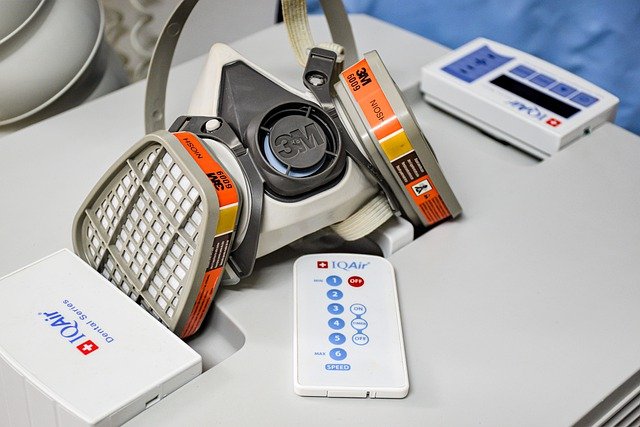We include products we think are useful for our readers. If you buy through links on this page, we may earn a small commission. Here’s our process.
Many brands manufacture air purifiers that remove dust particles from the air. They can be suitable for people with asthma and allergy symptoms. These devices come in various sizes, while some have an adjustable fan speed and sleep mode feature to minimize sleep disruptions.
This article explores the benefits of air purifiers for dust, features to look for when choosing a device, and some products available on the market. It also looks at some frequently asked questions.
The Centers for Disease Control and Prevention (CDC) state that low outdoor air quality can be detrimental to health. The organization also says that many people experience exposure to smog and particle pollution.
However, a 2016 article also notes that indoor pollutant levels can be up to 100 times more than outdoor pollutant levels.
One of the harmful pollutants that individuals can find indoors is dust. It comes from dead skin cells, stray particulates, and dust mites, which are major triggers for people with allergies and asthma, according to the American Lung Association.
In addition, one article found that house dust and its components also have associations with respiratory infections, wheezing, and respiratory allergic diseases.
People can improve their indoor air quality by reducing sources of contamination, such as smoking.
However, it is impossible to remove all harmful particles from the air. A 2020 article states that walking around and sitting on furniture can lead to 25% of indoor particulate matter concentrations.
Using air purifiers to remove dust can reduce concentrations of small particles by 30–80%, which offers some of the following health benefits:
When it comes to using air purifiers for dust removal, people should consider the filters they use.
According to the Environmental Protection Agency (EPA), devices with a high-efficiency particulate air (HEPA) filter can remove 99.97% of airborne particles with a size of 0.3 microns. These include dust, pollen, mold, and bacteria.
Learn more about HEPA air purifiers.
There are some features to consider when choosing an air purifier for dust:
- Clean Air Delivery Rate (CADR): Refers to the volume of particles the unit can filter in a set time, and it should match the size of the room where a person will use it.
- Target use: Some air purifiers work on removing particles, while others focus on gases. People looking for air purifiers for dust control should look for filters that target dust removal specifically.
- Filters: Some devices feature more than one filter, so a person should check when they should replace them.
- Fan speed: There are devices featuring fans that adjust their speeds according to the pollutant levels. Their speed also lowers during the night, so the unit does not disturb sleeping people.
The below is a review of five of the best air purifiers for dust.
Please note that the writer of this article has not tried these products. All information presented is purely research-based.
Blue Pure 211+ Air Purifier
This Blue Pure air purifier can filter large rooms up to 540 square feet (sq. ft) 4.8 times an hour.
It has an auto-mode feature, which adjusts fan speed according to air quality.
Its three-part filtration system includes a fabric pre-filter, a combined particle and carbon filter, and a main particle filter.
The air purifier also comes with HEPASilent filtration.
Honeywell True HEPA Air Purifier with Allergen Remover
This air purifier comes with a HEPA filtration system and an activated carbon pre-filter, and it is suitable for 465 sq. ft rooms.
It has an Energy Star rating for energy efficiency and also features:
- three power settings
- an automatic shut-off timer
- a filter change indicator
Coway AP-1512HH Mighty Air Purifier
This compact air purifier uses a four-stage filtration system to reduce levels of dust, pet dander, odors, and other contaminants in rooms up to 361 sq. ft in size.
The filtration system comprises a washable pre-filter, odor filter, a HEPA filter, and a vital ionizer.
Its onboard air quality indicator also monitors particle levels and adjusts the fan speed accordingly.
LEVOIT Air Purifier LV-H132
LEVOIT’s unit is suitable for individuals with rooms of up to 129 sq. ft.
It has a portable design and features a three-stage filtration system:
- The pre-filter stage captures large particles.
- The HEPA filter removes dust, pollen, and pet dander.
- The carbon filter traps odors and volatile organic compounds.
Additionally, the device has night light levels and a sleep mode function that allows the fan to operate at the lowest speed during the night.
Winix 5500-2 Air Purifier with PlasmaWave
This air purifier fits rooms up to 360 sq. ft in size. It has a four-stage filtration system and can remove dust, smoke, and pollen.
It also features a washable fine mesh pre-filter, a washable carbon filter, and a HEPA filter. It also comes with PlasmaWave technology that reportedly helps neutralize airborne bacteria.
Its air quality sensors adjust the fan speed as necessary, while the sleep mode activates when the room’s lights are off.
The following are common questions and answers about air filters for dust.
What do air purifiers do?
According to the EPA, air purifiers draw in air through one or more filters to capture harmful particles that may come from dust, tobacco smoke, or pet dander.
Do air purifiers work for dust?
The EPA states that many air purifiers for dust can remove particles from the rooms where people place them. The devices need to be compatible with the size of the room for them to be effective.
Do air purifiers help with allergies?
A 2018 guide shows that HEPA air cleaners can be effective in reducing allergy or asthma symptoms.
However, these improvements may not benefit all respiratory symptoms.
Is an air purifier worth the price?
According to Consumer Reports, air purifiers are expensive, with recommended models generally costing $200-900.
A person should also consider filter replacements, which can cost around $90–175 per year. Additionally, the annual energy cost of running an air purifier may range from around $30 to almost $90.
In addition, some units can be noisy and cause sleep disruptions.
Air purifiers can be effective in removing dust indoors and improving asthma and allergy symptoms.
They come with different filters, but studies show that HEPA filters can remove most airborne particles, including pollen, mold, and bacteria.
A person should also choose a device compatible with their room size.
Source: https://www.medicalnewstoday.com/articles/air-purifiers-for-dust









